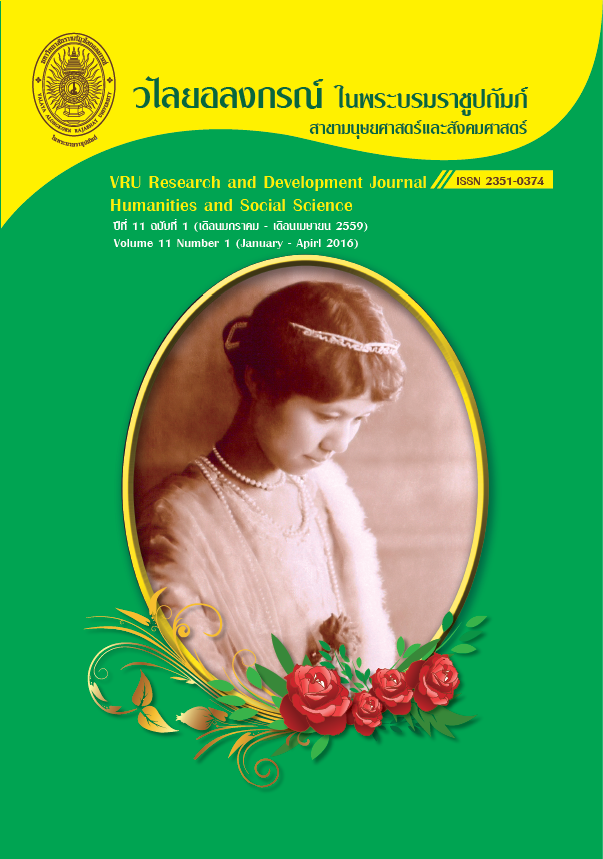การพัฒนารูปแบบการสื่อสารรณรงค์เพื่อการจัดการขยะมูลฝอยชุมชนแบบบูรณาการในจังหวัดประจวบคีรีขันธ์
Main Article Content
Abstract
การวิจัยเรื่องการพัฒนารูปแบบการสื่อสารรณรงค์เพื่อการจัดการขยะมูลฝอยชุมชนแบบบูรณาการในจังหวัดประจวบคีรีขันธ์ มีวัตถุประสงค์เพื่อศึกษาการเปิดรับข่าวสารการรณรงค์ สภาพปัญหา นโยบายและแนวทาง การสื่อสารรณรงค์ความสัมพันธ์ระหว่าง ความรู้ ทัศนคติ และพฤติกรรม และสร้างรูปแบบการสื่อสารรณรงค์เพื่อการจัดการขยะมูลฝอยชุมชนแบบบูรณาการในจังหวัดประจวบคีรีขันธ์ เป็นการวิจัยเชิงปริมาณ เพื่อสำรวจ ความคิดเห็นของประชาชนในเขตเทศบาลในจังหวัดประจวบคีรีขันธ์ จำนวน 400 คน โดยใช้แบบสอบถามสำหรับการวิจัยเชิงคุณภาพใช้วิธีสัมภาษณ์เชิงลึกกับผู้บริหารกองสาธารณสุขและสิ่งแวดล้อมและแกนนำชุมชน จำนวน 14 คน และสนทนากลุ่ม เพื่อตรวจสอบรูปแบบการสื่อสารรณรงค์เพื่อการจัดการขยะมูลฝอยชุมชนแบบบูรณาการ ในจังหวัดประจวบคีรีขันธ์ การวิเคราะห์ข้อมูลใช้ค่าสถิติ ได้แก่ ค่าความถี่ ค่าร้อยละ ค่าเฉลี่ย ส่วนเบี่ยงเบนมาตรฐาน t – test การวิเคราะห์ความแปรปรวนทางเดียว สัมประสิทธิ์สหสัมพันธ์แบบเพียร์สัน การวิเคราะห์และสังเคราะห์ข้อมูลเชิงคุณภาพ
1) การวิจัยเชิงปริมาณ พบว่ากลุ่มตัวอย่างส่วนใหญ่มีความถี่ในการเปิดรับข่าวสาร การรณรงค์ในระดับน้อย สภาพปัญหาจากเทศบาล ประชาชน และชุมชนมีการจัดการขยะมูลฝอยชุมชนแบบบูรณาการในระดับปานกลาง ภาพรวมการจัดการขยะมูลฝอยชุมชนแบบบูรณาการในจังหวัดประจวบคีรีขันธ์มีความรู้ในระดับมาก ทัศนคติในระดับเห็นด้วยมาก และพฤติกรรมในระดับปฏิบัติ เป็นบางครั้ง การทดสอบสมมติฐาน พบว่า ระดับการศึกษาและรายได้ต่างกันมีทัศนคติและพฤติกรรมการจัดการขยะมูลฝอยชุมชนแบบบูรณาการในจังหวัดประจวบคีรีขันธ์แตกต่างกันอย่างมีนัยสำคัญทางสถิติที่ระดับ 0.05 ความสัมพันธ์การเปิดรับข่าวสาร การรณรงค์ ความถี่จากสื่อประชาสัมพันธ์เทศบาลมีความสัมพันธ์กับทัศนคติและพฤติกรรมส่วนความสัมพันธ์สภาพปัญหา ความรู้ ทัศนคติ และพฤติกรรม การจัดการขยะมูลฝอยชุมชนแบบบูรณาการในจังหวัดประจวบคีรีขันธ์มีความสัมพันธ์ ในทิศทางเดียวกันอย่างมีนัยสำคัญทางสถิติที่ระดับ 0.05
2) การวิจัยเชิงคุณภาพ พบว่าท้องถิ่นเทศบาลมีนโยบายและแนวทางการสื่อสารรณรงค์เพื่อการจัดการขยะมูลฝอยชุมชนแบบบูรณาการในจังหวัดประจวบคีรีขันธ์ โดยใช้สื่อรณรงค์เพื่อการเข้าถึง โน้มน้าวใจและการมีส่วนร่วมในการจัดการขยะมูลฝอยชุมชนอย่างครบวงจร และผู้วิจัยนำผลการวิจัยครั้งนี้มาพัฒนาเพื่อสร้างรูปแบบการสื่อสารรณรงค์หลักปฏิบัติการจัดการขยะมูลฝอยโดยชุมชน (3 Rs – CSM Model) ประกอบด้วย R = Reduce/การลดการใช้ R = Reuse/การใช้ช้ำ R = Recycle/การนำกลับมาใช้ใหม่ C = Community participation/การมีส่วนร่วมของชุมชน Selective exposure/การเลือกเปิดรับข่าวสาร และ M = Management/การจัดการภาพรวมการสนทนากลุ่มการพัฒนารูปแบบการสื่อสารรณรงค์เพื่อการจัดการขยะมูลฝอยชุมชนแบบบูรณาการในจังหวัดประจวบคีรีขันธ์อยู่ในระดับเห็นด้วยมากที่สุด
The dissertation in the title of “The Development of Communication Campaign Model for Integrated Community Solid Waste Management in Prachuap Khirikhan Province”, aimed to study the exposure of campaign messages, policy and guideline decision making for communication campaign. It is depending on the relationship between three factors; knowledge, attitude and behavior, and then design the communication campaign’ model. This is a mixed research between the qualitative and quantitative methods; in term of quantitative method the data collecting by questionnaires from the sampling group of 400 people in Prachuap Khirikhan municipality. While the 14 person as the administrators of the Environment and Public Health, the community leaders were interviewed and discussed in group for the quantitative aspect. The data was analyzed by the frequency, percentage, mean, standard deviation, t-test, One-way Annova and Pearsan’s product moment correlation coefficient, and the analysis and synthesis methods were employed for the qualitative aspect.
The result(s) reveal by the following;
1) For quantitative method, it was found that the frequency of campaign exposure was in less, and the problems from municipality, local people and community for integrated solid waste management were in the moderate level. Overall of this finding was in highly ranking in knowledge, attitude but in moderate level in practicum. In hypothesis testing, revealed the educational level and income was not difference attitude and practice on integrated community solid waste management at 0.05. There was the relationship between willingness to get information campaign, frequency of municipal public relation. There was a statistic significantly difference at 0.05 on the relationship between problems, knowledge, attitude and practice on integrated community solid waste management in Prachuap Khirikhan. Knowledge and attitude with practice had statistic significantly difference at 0.05.
2) In terms of qualitative aspect, the results showed that municipality had the policy and guidelines in communication campaign for integrated community solid waste management in Prachuap Khirikhan by implementing media for access, persuasion and cooperation in community solid waste management in all aspects. The researcher developed the results gained to create the model in communication campaign as Practice Principles for Solid Waste Management by Community (3 Rs – CSM Model) which refers to Reduce, Reuse, Recycle, Community participation, Selective exposure and Management. Management, group discussion in the development of communication campaign for integrated community solid waste management were in highest level.
Article Details
ลิขสิทธิ์บทความวิจัยที่ได้รับการตีพิมพ์เผยแพร่ในวารสารมนุษยศาสตร์และสังคมศาสตร์ วไลยอลงกรณ์ ในพระบรมราชูปถัมภ์ ถือเป็นกรรมสิทธิ์ของคณะมนุษยศาสตร์และสังคมศาสตร์ มหาวิทยาลัยราชภัฏวไลยอลงกรณ์ ในพระบรมราชูปถัมภ์ ห้ามนำข้อความทั้งหมดหรือบางส่วนไปพิมพ์ซ้ำ เว้นแต่จะได้รับอนุญาตจากมหาวิทยาลัยเป็นลายลักษณ์อักษร
ความรับผิดชอบ เนื้อหาต้นฉบับที่ปรากฏในวารสารมนุษยศาสตร์และสังคมศาสตร์ วไลยอลงกรณ์ ในพระบรมราชูปถัมภ์ เป็นความรับผิดชอบของผู้นิพนธ์บทความหรือผู้เขียนเอง ทั้งนี้ไม่รวมความผิดพลาดอันเกิดจากเทคนิคการพิมพ์
References
กรมส่งเสริมคุณภาพสิ่งแวดล้อม. (2554). คู่มือการจัดการขยะมูลฝอยชุมชน. (พิมพ์ครั้งที่ 6). กรุงเทพมหานคร : กรมส่งเสริมคุณภาพสิ่งแวดล้อม.
กรรณิการ์ อัศวดรเดชา. (2550). การสื่อสารเพื่อการโน้มน้าวใจ. กรุงเทพมหานคร : จุฬาลงกรณ์มหาวิทยาลัย.
กลุ่มงานราชกิจจานุเบกษา. (2554). แผนพัฒนาเศรษฐกิจและสังคมแห่งชาติ ฉบับที่ 11 (พ.ศ. 2555-2559). กรุงเทพมหานคร : สำนักนิติธรรม สำนักเลขาธิการคณะรัฐมนตรี.
กิติมา สุรสนธิ. (2548). ความรู้ทางการสื่อสาร. (พิมพ์ครั้งที่ 4). กรุงเทพมหานคร : มหาวิทยาลัยธรรมศาสตร์.
เกศินี จุฑาวิจิตร. (2548). การสื่อสารเพื่อการพัฒนาท้องถิ่น. (พิมพ์ครั้งที่ 3). นครปฐม : มหาวิทยาลัยราชภัฏนครปฐม.
คาวาเซ, ทาเกะชิ. (2547). คน – ศูนย์กลางของการแก้ไขปัญหา : หลักการบริหารเพื่อการปรับปรุง (แปลจาก Human – Centered Problem Solving : The Management of Improvements โดย ธานี อ่วมอ้อ). กรุงเทพมหานคร : ซีเอ็ดยูเคชั่น.
ธเรศ ศรีสถิตย์. (2553). วิศวกรรมการจัดการมูลฝอยชุมชน. กรุงเทพมหานคร : จุฬาลงกรณ์มหาวิทยาลัย.
สำนักงานทรัพยากรธรรมชาติและสิ่งแวดล้อมจังหวัดประจวบคีรีขันธ์. (2553). แผนปฏิบัติการเพื่อการจัดการขยะรวมจังหวัดประจวบคีรีขันธ์. ประจวบคีรรีขันธ์ : กระทรวงทรัพยากรธรรมชาติและสิ่งแวดล้อม.
สำนักงานนโยบายและแผนทรัพยากรธรรมชาติและสิ่งแวดล้อม. (2555). แผนจัดการคุณภาพสิ่งแวดล้อม พ.ศ. 2555-2559. กรุงเทพมหานคร : สำนักงานนโยบายและแผนทรัพยากรธรรมชาติและสิ่งแวดล้อม.
สุรัตน์ ตรีสกุล. (2550). หลักนิเทศศาสตร์. (พิมพ์ครั้งที่ 4 ). กรุงเทพมหานคร : มหาวิทยาลัยราชภัฏสวนสุนันทา.
อรวรรณ ปิลันธน์โอวาท. (2554). การสื่อสารเพื่อโน้มน้าวใจ. (พิมพ์ครั้งที่ 6). กรุงเทพมหานคร : จุฬาลงกรณ์มหาวิทยาลัย.
Davison, D.E. (1974). The Periodicals Collection : its Purpose and Use in Liberies. Andre Deutsch.
DeFleur, Melvin L. (1996). Theories of Mass Communication. New York : David McKey.
Doug, Newsom. (2000). This is PR : the Realities of Public Relations. (7th ed.). Belmont, Calif : Wadsworth Thomson Learning.
Good, Carter V. (1973). Dictionary of Education. New York : Mc Graw Hill.
Jacobson, T., & Kolluri, S. (1999). Participatory Communication as Communication Action. In T. Jacobson., & J. Servaes (eds.). Theoretical Approaches to Participatory Communication. Cresskill, New York : Hampton Press.
Klapper, Joseph T. (1960). The Effect of Mass Communication. New York : The Free Press.
McQuail, D. (1983). Mass Communication Theory. Newbury Park, CA : Sage.
Rogers, Everett M., & Shoemaker, Floyd. (1971). Communication of Innovation : A Cross Cultural Approach. New York : The Free Press.
Shan, K.L. (2000). Basic of Solid and Hazardous Waste Management Technology. New Jersey : Prentice-Hall.
Singhal, A. (2001). Facilitating Community Participation Through Communication. New York : Unicef.
Tchobanoglous, G., Theisen, H. & Vigil, S. (1993). Integrated Solid Waste Management : Engineering Principle and Manage


